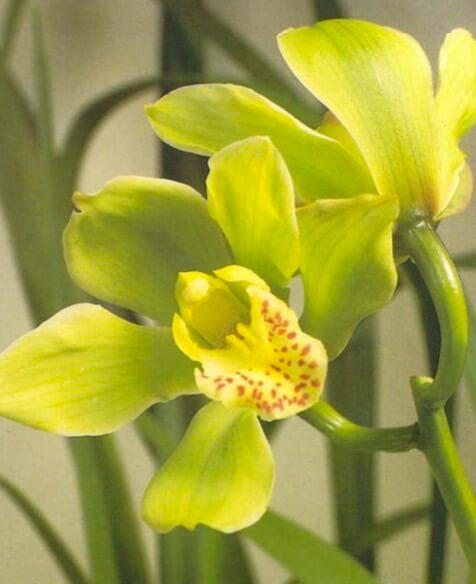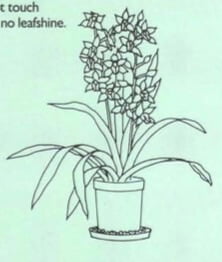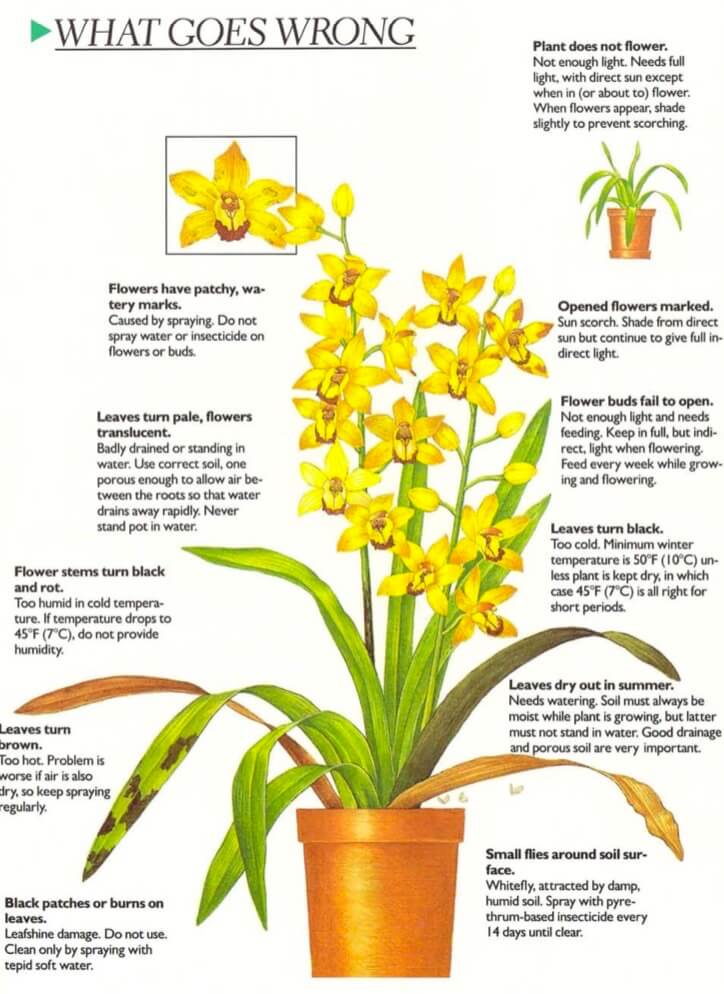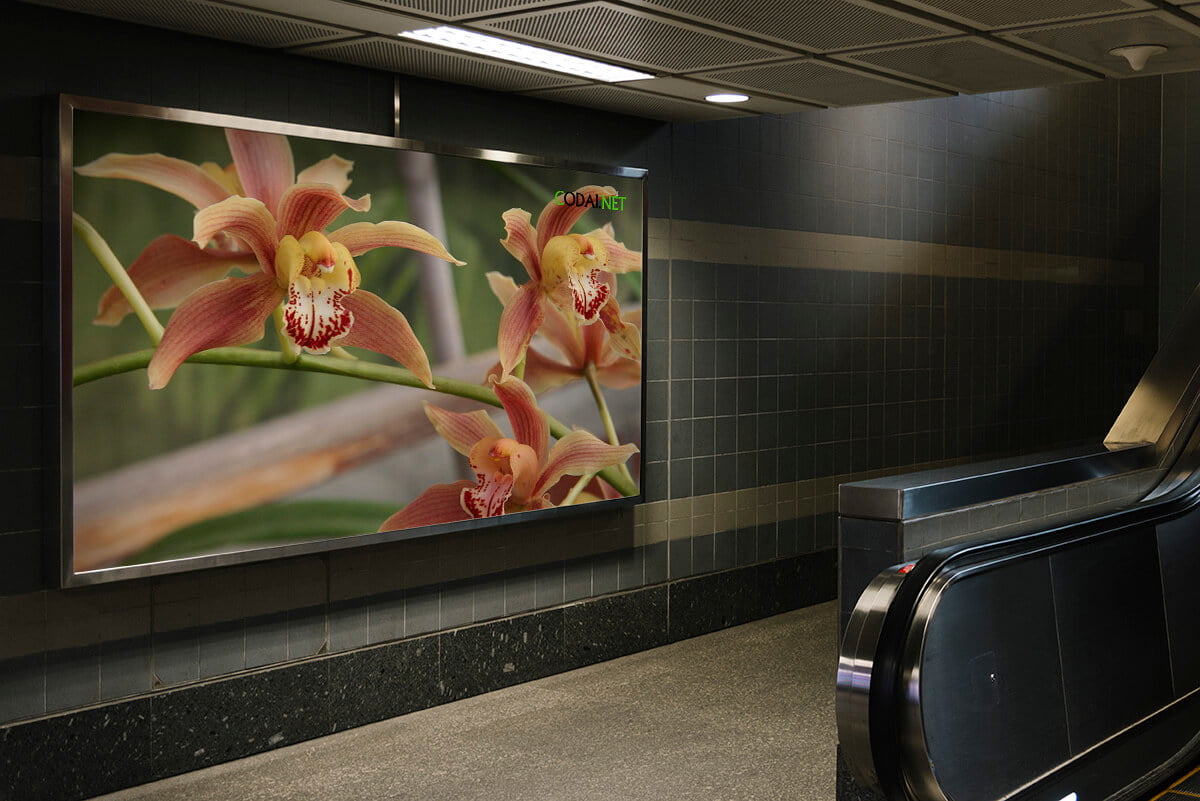[Ebook Việt Hoá] The Instant Guide to Healthy Houseplants (Hướng dẫn tức thời để chăm cây trong nhà khoẻ mạnh), Chi Cymbidium
[Ebook Việt Hoá] The Instant Guide to Healthy Houseplants: Cymbidium species (Cymbidum orchid)
- Nguồn: [Ebook Việt Hoá] The Instant Guide to Healthy Houseplants (Hướng dẫn tức thời để chăm cây trong nhà khoẻ mạnh)
- Biên tập: Dũng Cá Xinh
- Biên dịch: Team Codai.net
English
Tile exotic cymbidium orchid, available in about 50 different species, has been a favorite with plant lovers for years. Once rare and expensive, this orchid is now within everyone’s reach thanks to modern propagation techniques that have produced literally thousands of hybrids. In keeping with their tropical origins, cymbidiums need bright sunlight and high humidity; however, they do best in cool to intermediate temperatures. They flower for about six weeks, then go through a long resting period.

Light
Abundant light is essential for regular flowering. Tolerates full sunlight except when in (or about to) flower. It benefits from being outdoors in summer.
Temperature
Winter minimum, 45°F (7°C) if dry; otherwise, 50°F 10°C at night, 50-55°F (10-13°C) during the day. In summer, keep as cool as possible at night, up to 70-80°F (21 -27°C) during the day.
Water
While growing and flowering, water 2-3 times a week to keep it moist. After flowering, reduce watering to once or twice a week for a resting period. Good drainage is essential.
Humidity
Spray every day with tepid soft water to encourage moist atmosphere with good air circulation. Stand pot on saucer of pebbles almost covered with water. If colder than 45°F (7°C) , remove saucer and do not spray.
Feeding
Feed weekly in the growing and flowering season with liquid houseplant food diluted according to the manufacturer’s instructions. Do not feed during the resting period after flowering until new growth starts.
Soil
Use 3 parts special fern (osmunda) fiber and I part sphagnum moss. Ready-mixed orchid mixtures are available, although experienced orchid growers experiment.
Repotting
After flowering in spring, transfer if plant is potbound. Check roots. Procedure is usually necessary every other year.
Cleaning
Humidity spraying should keep leaves clean. If dusty, wipe with moist cloth. Do not touch flower spikes. Use no leafshine.

What Goes Wrong

- Plant does not flower: Not enough light. Needs full light, with direct sun except when in (or about to) flower. When flowers appear, shade slightly to prevent scorching.
- Flowers have patchy, watery marks: Caused by spraying. Do not spray water or insecticide on flowers or buds.
- Leaves turn pale, flowers translucent: Badly drained or standing in water. Use correct soil, one porous enough to allow air between the roots so that water drains away rapidly. Never stand pot in water.
- Flower stems turn black and rot: Too humid in cold temperature. If temperature drops to 45°F (7°C), do not provide humidity.
- Leaves turn brown: Too hot. Problem is worse if air is also dry, so keep spraying regularly.
- Black patches or bums on leaves: Leafshine damage. Do not use. Clean only by spraying with tepid soft water.
- Opened flowers marked: Sun scorch. Shade from direct sun but continue to give full indirect light.
- Flower buds fail to open: Not enough light and needs feeding. Keep in full, but indirect, light when flowering. Feed every week while growing and flowering.
- Leaves turn black: Too cold. Minimum winter temperature is 50°F (10°C) unless plant is kept dry, in which case 45°F(7°C) is all right for short periods.
- Leaves dry out in summer: Needs watering. Soil must always be moist while plant is growing, but latter must not stand in water. Good drainage and porous soil are very important.
- Small flies around soil surface: Whitefly, attracted by damp, humid soil. Spray with pyrethrum-based insecticide every 14 days until clear.
Tiếng Việt
Phong lan Địa Lan ngoại lai có khoảng 50 loài khác nhau, là một loài cây yêu thích của những người yêu thực vật trong nhiều năm nay. Từng hiếm và đắt đỏ, loài Lan này giờ đây đã nằm trong tầm ngắm của mọi người nhờ kỹ thuật nhân giống hiện đại đã tạo ra hàng nghìn cây lai theo đúng nghĩa đen. Để phù hợp với nguồn gốc nhiệt đới của chúng, Địa Lan cần ánh nắng chói chang và độ ẩm cao; tuy nhiên, chúng hoạt động tốt nhất ở nhiệt độ từ mát đến trung bình. Chúng ra hoa trong khoảng sáu tuần, sau đó trải qua một thời gian dài nghỉ ngơi.

Ánh sáng
Ánh sáng dồi dào là điều cần thiết để cây ra hoa thường xuyên. Chịu được ánh nắng chói chang trừ khi hoa đang (hoặc sắp) nở. Nó có lợi khi ở ngoài trời vào mùa hè.
Nhiệt độ
Mùa đông tối thiểu 45 độ F (7 độ C) nếu khô; nếu không 50 độ F ( 10 độ C ) vào ban đêm, 50-55 độ F (10-13 độ C) vào ban ngày. Vào mùa hè, giữ mát nhất có thể vào ban đêm, lên đến 70-80 độ F (21 -27 độ C) vào ban ngày .
Nước
Trong thời gian cây phát triển và ra hoa, tưới 2-3 lần một tuần để giữ ẩm. Sau khi cây ra hoa, giảm tưới nước xuống một hoặc hai lần một tuần để cây nghỉ ngơi. Hệ thống thoát nước tốt là điều cần thiết.
Độ ẩm
Xịt mỗi ngày bằng nước ấm để tạo bầu không khí ẩm và không khí lưu thông tốt. Đặt chậu trên một đĩa sỏi gần như phủ đầy nước. Nếu lạnh hơn 45 độ F (7 độ C), hãy lấy đĩa ra và không xịt.
Bón phân
Bón phân hàng tuần trong mùa sinh trưởng và ra hoa bằng phân bón dạng lỏng được pha loãng theo hướng dẫn của nhà sản xuất. Không bón phân trong thời gian nghỉ ngơi sau khi ra hoa cho đến khi bắt đầu tăng trưởng mới.
Đất
Sử dụng 3 phần sợi dương xỉ đặc biệt (osmunda) và một phần rêu sphagnum. Hỗn hợp hoa Lan trộn sẵn có sẵn, mặc dù những người trồng lan có kinh nghiệm thử nghiệm.
Thay chậu
Sau khi cây ra hoa vào mùa xuân, chuyển nếu cây đã bén rễ. Kiểm tra rễ. Thủ tục thường là cần thiết mỗi năm một lần.
Làm sạch
Phun ẩm nên giữ cho lá luôn sạch sẽ. Nếu có bụi, hãy lau bằng vải ẩm. Không chạm vào gai hoa. Không sử dụng xịt bóng lá.

Những vấn đề có thể xảy ra

- Cây không ra hoa: Không đủ ánh sáng. Cần ánh sáng đầy đủ, có ánh nắng trực tiếp trừ khi cây đang (hoặc sắp) ra hoa. Khi hoa nở, che bóng nhẹ để không bị cháy lá.
- Hoa có vết loang lổ, chảy nước: Nguyên nhân do phun thuốc. Không phun nước hoặc thuốc trừ sâu lên hoa hoặc nụ
- Lá nhợt nhạt, hoa mờ: Thoát nước kém hoặc đọng nước. Sử dụng đất phù hợp, đủ xốp để có không khí giữa các rễ để nước thoát đi nhanh chóng. Không bao giờ để chậu đọng nước.
- Cành hoa chuyển sang màu đen và thối rữa: Quá ẩm trong nhiệt độ lạnh. Nếu nhiệt độ giảm xuống 45 độ F (7 độ C), không cung cấp độ ẩm.
- Lá chuyển sang màu nâu: Quá nóng. Vấn đề tồi tệ hơn nếu không khí cũng khô, vì vậy hãy tiếp tục xịt nước thường xuyên.
- Các mảng hoặc đốm đen trên lá: Bệnh do xịt bóng lá gây hại. Không được dùng. Chỉ làm sạch bằng cách phun với nước ấm.
- Vết cháy xém của hay: Cháy nắng. Che nắng trực tiếp nhưng vẫn tiếp tục cung cấp đầy đủ ánh sáng gián tiếp.
- Nụ hoa không nở: Không đủ ánh sáng và cần bón phân. Giữ ánh sáng đầy đủ, nhưng gián tiếp, khi ra hoa. Bón phân hàng tuần khi cây đang phát triển và ra hoa.
- Lá chuyển sang màu đen: Quá lạnh. Nhiệt độ mùa đông tối thiểu là 50 độ F (10 độ C) trừ khi cây được giữ khô ráo, trong trường hợp đó, 45 độ F (7 độ C) là phù hợp trong thời gian ngắn.
- Lá khô vào mùa hè: Cần tưới nước. Đất phải luôn ẩm trong khi cây phát triển, nhưng đất không được để trong nước. Thoát nước tốt và đất xốp là rất quan trọng.
- Ruồi nhỏ xung quanh bề mặt đất: Ruồi trắng, bị thu hút bởi đất ẩm, ẩm ướt. Phun thuốc trừ sâu gốc cây kim châm 14 ngày một lần cho đến khi sạch bệnh.



